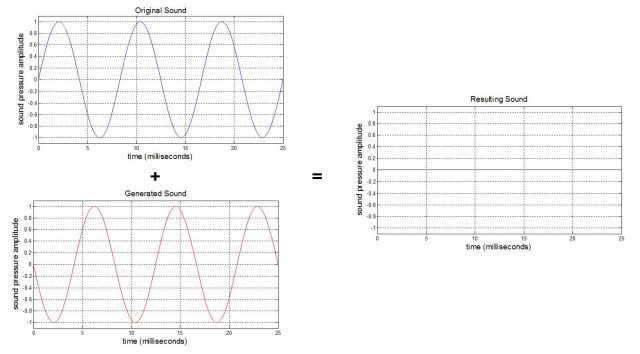David L. Bowen
Product Sound | Market Leader
Labs + Sensitive Facilities | Market Co-Leader
Principal

As product sound engineers, we field a lot of questions—which is definitely understandable. It is a highly specialized focus that can make the difference between success and failure in a consumer-driven market. Often times, the questions we receive hover around the following issues:
‘“Why can’t we get rid of that sound by just using active noise cancellation?”
Or,
“Why can’t we just create a ‘zone of silence’ here using active noise control?”
These are reasonable questions, which are undoubtedly prompted by various articles in the popular press and by the very successful application of active noise cancellation (ANC) techniques to headphones and earphones. But, before trying to answer the “Why can’t we…” question, I’d like to first review why active cancellation of sound can (sometimes) work in the first place.
At its most basic level, the concept of ANC is relatively straightforward (in fact, the first ANC patent was granted back in the 1930’s, but the technology wasn’t around then to actually implement it in any practical sense). The sound we might hear at any location is fundamentally an oscillation of the air pressure about the mean atmospheric pressure at that location. We call this sound pressure. Just how fast these oscillations in pressure occur determines the frequency or “pitch” of the sound (oscillations in the range of roughly 20 to 20,000 times per second – i.e., “Hz” – are heard as sound – the full range here if you have very good hearing), while the amplitude or strength of the oscillations determines the “loudness” of the sound. The blue curve below is a short snapshot of a 120 Hz “hum” sound, showing how the sound pressure of this disturbing sound varies with time at a given location (the sound keeps going on like this for much longer than the 25 milliseconds shown – i.e., it’s periodic – but we’re zooming in for clarity). Now, suppose we could somehow generate another sound (via a loudspeaker for example) that would, at this same location, be in effect the mirror image of the original (blue) sound in terms of how its pressure changes with time – that is, equal in strength and frequency, but exactly “180 degrees out of phase” with the original disturbing sound. Such an “anti-sound” is denoted by the red curve below. Then, these two sounds would combine to exactly cancel each other out at this location, resulting in the black curve (i.e., nothing).

Simple enough, right? Well, the devil’s in the details as they say, and there can be a lot of details that come up in the real world of acoustics and, in particular, active noise control.
The first detail that might come to mind is how do you know you’re generating the correct sound to properly cancel out the existing sound? After all, if instead of being 180 degrees out of phase with the blue sound, our red cancelling sound above were identical to it, then the two sounds would combine so as to double the strength of the original sound instead of cancelling it out. While you might conceptually conceive of adjusting a knob or two to control critical aspects of the cancelling sound so that the result is minimal noise at your ears, this would quickly become a tiresome task as subtle changes in the sound and/or the environment took place. In practice, essentially this same thing can be accomplished using a computer and microphone or some other reference signal to monitor the original disturbing sound, and one or more additional “error” microphones to monitor the resulting sound. The signals from these components are then used as inputs to either analog or (more commonly) digital signal processing to carry out various flavors of feedback/feedforward control algorithms that constantly adjust the cancellation signal sent to the cancelling loudspeaker(s) so that sound at the monitoring location is minimized. This approach also has the advantage that the cancellation signal can readily adapt if the original disturbing sound “drifts” over time in terms of its level, frequency or phase characteristics.
There are, however, certain limitations that come into play which can defeat such an active noise cancellation approach. These can generally be grouped into limitations associated with practical issues of implementation and algorithm selection, electronics, processing speed, etc., and those associated with the basic physics of the situation. Both can influence two important aspects governing performance of an ANC approach to noise reduction:
(1) The frequency range over which ANC may be effective (in particular the upper frequency limit) and stable.
(2) The space over which it’ll be effective.
Broadly speaking, ANC is easiest to carry out when the sound pressure is oscillating relatively slowly – i.e., its frequency is “low” (generally no higher than a few hundred hertz, or at most 1000 Hz in some specific applications like noise cancelling headphones – more about these devices later).
As frequency increases, it becomes harder for the cancellation to keep up. However, this low frequency performance can complement traditional noise control techniques that rely on materials to provide sound absorption and/or sound isolation, and which generally perform best at higher frequencies.
Another factor that can make life hard for an ANC system is to require it to exert control over an electro-acoustic system with many “degrees of freedom”. Each of these degrees of freedom or “modes” can be thought of as an independent entity that the ANC system has to keep up with and control. This often implies more sensors, greater complexity and cost if you’re interested in obtaining “global” control over a large space rather than just local control at one or just a few specific locations (i.e., it may be relatively easy to use ANC to reduce the sound level at one location within a room, but if you aren’t careful you could easily make it louder at many other locations in that room). In this respect lower frequencies – with their associated longer wavelengths – and smaller spaces are advantageous for ANC in that they both serve to reduce the ability of the sound field to change significantly from point to point. In noise cancelling headphones or earbuds, the relatively small space between the headphone speaker and the eardrum is one reason that ANC can be made to work so well in these applications.
As in standard noise control, active control can also benefit from the notion of trying to control the source of sound rather than just the resulting sound at specific locations within a space. Such a strategy often implies fewer hardware components (i.e., sensor and speakers), a simpler control algorithm, and lower cost.
For example, I once had a project where the goal was reduce audible gear “whine” inside certain models of passenger vans. It turned out that this particular noise was due to vibration associated with gears meshing inside the differential underneath the van, which then transmitted into the flooring of the van where it could be radiated very efficiently as sound. Rather than design a complicated system relying on multiple speakers and microphones placed strategically inside the van, we instead tackled the root cause by installing just two small vibration actuators (near the points where the differential was connected to the rest of the vehicle), along with a vibration sensor to provide feedback to the control system. This canceled out the vibration at its source, and thus the resulting sound heard inside the vehicle -measured gear whine reductions in the range of 10 to 15 dB were achieved over the entire volume of the passenger compartment.
Aside from headphones, there are several other specialized applications where active cancellation is often a viable option. Commercial systems that are out there now include active vibration isolation systems for optical tables and the like, and some duct silencers incorporating active noise control. In each of these cases there are a minimal number of degrees of freedom to have to worry about controlling. Active muffler systems for vehicles were also in development for a while, but the practical aspects of creating robust enough components that could live for years in the hostile environment underneath a car eventually proved to be financially insurmountable for widespread adoption.
In closing, I’d just like to point out that while active noise cancellation certainly has its place and is one more tool in our arsenal, it, like all potential solutions we evaluate, ultimately has to be considered in comparison to other alternatives that may be more effective and/or less expensive for our clients to implement. As always, methodical analyses and careful implementation are keys to any successful noise reduction program.